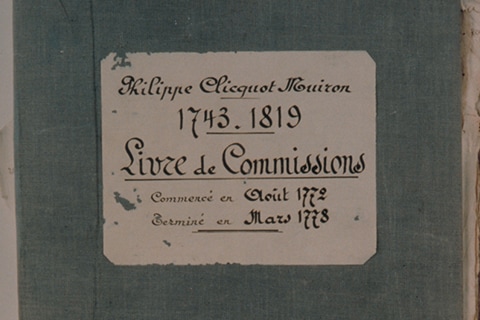BRAND HISTORY

THE STORY OF VEUVE CLICQUOT
1772

1772
FOUNDATION OF THE “CLICQUOT” HOUSE
Phillipe Clicquot, son to a family of bankers and textile merchants and owner of a number of vineyards, decides to establish a wine business under the family name, pledging to have his wares "cross all borders". The business's very first shipment leaves for Venice. His son François joins the business in 1798.
THE STORY OF VEUVE CLICQUOT
1805

1805
DEATH OF FRANÇOIS CLICQUOT
His widow, Barbe Nicole Clicquot Ponsardin, decides to take on the family business at the age of 27, and thus becomes one of the first modern business women. That year, 110 thousand bottles are shipped, 25 thousand of which are intended for Russia.
THE STORY OF VEUVE CLICQUOT
1811

1811
THE GREAT COMET – THE COMET VINTAGE
Exceptional harvests (attributed to a comet that cut through the Champagne sky) lead to an outstanding vintage: the Comet Cuvée.
THE STORY OF VEUVE CLICQUOT
1816

1816
INVENTION OF THE RIDDLING TABLE
Madame Clicquot invents the first Riddling Table, which makes it possible to ensure crystal-clear wine. This process continues to be used today. From then on, the House goes from strength to strength. Madame Clicquot becomes known to her peers as "La Grande Dame" of Champagne.
THE STORY OF VEUVE CLICQUOT
1818

1818
CREATION OF THE FIRST "ROSÉ D'ASSEMBLAGE"
Breaking away from the tradition of adding an elderberry-based preparation to create rosé champagne. Madame Clicquot creates the first "rosé d'assemblage" by blending some of her Bouzy red wines with her champagne.
THE STORY OF VEUVE CLICQUOT
1877

1877
REGISTRATION OF THE YELLOW LABEL TRADEMARK
The House continues to show its innovative spirit by providing its bottles with a yellow label, an unusual color for the time. The "V. Clicquot P. Werlé" yellow label trademark is registered on 12 February 1877. Customers demand this distinctive, original label, which is to become one of the main marks of recognition for bottles produced by the House.
THE STORY OF VEUVE CLICQUOT
1909

1909
PURCHASE OF THE CRAYÈRES CHALK TUNNELS
On the impetus of Bertrand de Mun, Veuve Clicquot Ponsardin introduces new techniques and continues to improve the quality of its wines using the latest discoveries in wine-making. The House extends its industrial facilities and sets up on the borders of Reims in 482 chalk tunnels, where the visitor center and production facilities are located to this day.
THE STORY OF VEUVE CLICQUOT
1972

1972
CREATION OF LA GRANDE DAME
AND THE CREATION OF BWA
In its bicentennial year, as the House is launching its prestigious Cuvée La Grande Dame, it also creates the Veuve Clicquot Business Woman of the Year Award, a tribute to the entrepreneurial spirit of Madame Clicquot. This award champions the success of women who have made their mark on the business world.
THE STORY OF VEUVE CLICQUOT
2004

2004
LAUNCH OF THE VEUVE CLICQUOT
CUVEE ROSÉ IN JAPAN
Launched in Japan during the cherry blossom season, Veuve Clicquot Rosé, the House's non-vintage Rosé, is so successful that the rest of the world has to wait until 2006 before the House can supply the remainder of the cuvée.
THE STORY OF VEUVE CLICQUOT
2010

2010
A MIRACULOUS BALTIC SEA DISCOVERY
In July 2010, some truly unique bottles of champagne were discovered in a shipwreck off Finland's Åland Islands, at the mouth of the Baltic. Despite having spent two centuries at the bottom of the sea, their contents are extremely well preserved. A salvage operation brought 145 bottles, including 47 Veuve Clicquot champagne bottles, to the surface. One of those champagnes, amongst the oldest champagne in the world, was sold. This wonderful discovery for the Veuve Clicquot House is testament to the impeccable quality of our wines dating back to the very origins of the House.
THE STORY OF VEUVE CLICQUOT
2011

2011
REOPENING OF THE HOTEL DU MARC
In 2011, after several years of renovations, the hotel turns a new page in its history, and reveals all its poetry and romantic beauty with a resolutely modern attitude. The Veuve Clicquot Ponsardin House entrusted Bruno Moinard with the restoration of the building, as he is known for this very personal approach to rewriting the history of a place, with infinite care and attention.
 Armand De Brignac
Armand De Brignac Dom Pérignon
Dom Pérignon Krug
Krug Moët & Chandon
Moët & Chandon Ruinart
Ruinart Veuve Clicquot
Veuve Clicquot Chandon
Chandon Château d’Esclans
Château d’Esclans Château Galoupet
Château Galoupet Château Minuty
Château Minuty Cloudy Bay
Cloudy Bay Joseph Phelps
Joseph Phelps Newton
Newton Numanthia
Numanthia Skyside
Skyside Taylor's
Taylor's Terrazas De Los Andes
Terrazas De Los Andes Ardbeg
Ardbeg Belvedere
Belvedere Glenmorangie
Glenmorangie Hennessy
Hennessy Old Parr
Old Parr Royal Household
Royal Household Talisker
Talisker Volcán de mi Tierra
Volcán de mi Tierra WhistlePig
WhistlePig


























